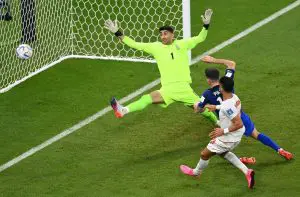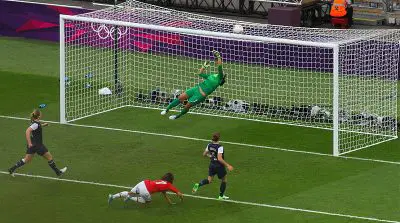The width of football goal posts is a fundamental aspect of the game, dictating the scoring potential and influencing the strategies of both offensive and defensive play. In this article, we will delve into the significance of goal post width, its historical evolution, and its impact on the dynamics of the beautiful game.
From the narrow goalmouths of early football to the standardized dimensions seen in modern soccer, understanding the width of goal posts provides valuable insights into the sport’s development and the excitement it brings to players and fans alike.
What is the official width of goal post in football?

The official width of a goal post in football, also known as soccer in some regions, is 7.32 meters or approximately 8 yards. This measurement is standardized by the International Football Association Board (IFAB), which is the governing body responsible for determining the rules and regulations of the game.
The goal posts are typically made of metal and consist of two upright posts and a horizontal crossbar. The two upright posts are placed at each end of the field and are connected by the crossbar, forming the rectangular shape of the goal. The crossbar is positioned horizontally and perpendicular to the goal line.
The goal’s width is crucial to the game, as it defines the area in which a goal can be scored. For a goal to be officially counted, the ball must completely cross the goal line between the two upright posts and beneath the crossbar.
The standardized dimensions of the goal posts ensure consistency and fairness across all levels of football, from local matches to international competitions. These dimensions are fundamental to the rules of the game, influencing strategies, gameplay, and scoring.
How is goal post width measured in football?
The width of the goal posts in football is measured horizontally between the inner edges of the two upright posts. Specifically, it is the distance between the inner side of one goalpost to the inner side of the opposite goalpost. This measurement is standardized and regulated by the governing bodies of football to maintain consistency and fairness in the game.
To measure the goal post width accurately:
- Identify the Inner Edges:
-
- Locate the inner edges of the two upright goal posts. These are the points where the goal net is attached to the posts.
- Use a Measuring Device:
-
- Use a measuring tape, ruler, or any suitable measuring device to measure the distance between the inner edges of the two goal posts.
- Measure Horizontally:
-
- Ensure that the measuring device is held horizontally and aligned with the inner edges of the goal posts. Measure from the inner edge of one post to the inner edge of the other.
- Record the Measurement:
-
- Record the measurement in meters or yards, depending on the preferred unit of measurement.
Standardly, the width of a football goal post is 7.32 meters (approximately 8 yards). This measurement is consistent across professional football matches and is regulated by the International Football Association Board (IFAB) to maintain uniformity in the game.
What are the dimensions of the goal post’s crossbar?
The dimensions of the goal post’s crossbar in football are also standardized by the International Football Association Board (IFAB). The crossbar, which is the horizontal bar connecting the two upright goal posts, is set at a height of 2.44 meters (8 feet) from the ground. This height remains constant and is consistent across all levels of the game, from local matches to international competitions.
The standardized crossbar height is a crucial element of the game, defining the boundary for scoring a goal. For a goal to be officially counted, the ball must completely cross the goal line beneath the crossbar and between the two upright posts.
This uniform crossbar height ensures fairness and consistency in the game, enabling players and teams to compete under the same set of rules and measurements.
Do international matches have specific goal post width requirements?
Yes, international football matches, organized and governed by FIFA (Fédération Internationale de Football Association), adhere to specific goal post width requirements set by the International Football Association Board (IFAB). The goal post width for international matches is standardized at 7.32 meters (approximately 8 yards).
This standardization ensures consistency and uniformity in the game of football at the international level. All FIFA-sanctioned matches, including World Cup matches and other international tournaments, follow these goal post width regulations to maintain a level playing field and uphold the fundamental rules of the sport.
The goal post width, along with other field and goal-related dimensions, is an essential aspect of the game, influencing gameplay and scoring. Adhering to consistent measurements allows for fair play and fair competition on the global stage.
How does width affect goal design in football?

Width in football refers to the horizontal dimension of the field, and it plays a crucial role in goal design and overall strategy. Here’s how width affects goal design and tactics in football:
- Creating Space for Attack:
-
- Utilizing the width of the field helps in creating more space for attacking play. Wider positioning of players stretches the opponent’s defense, creating gaps and opportunities to penetrate the defensive lines.
- Crossing Opportunities:
-
- A wider field provides more room for wingers and fullbacks to make runs down the flanks and deliver crosses into the box. Crosses from wide positions can be effective in scoring goals, especially if there are tall or aerially proficient strikers in the team.
- Exploiting the Flanks:
-
- Wider play allows a team to exploit the flanks and attack from the sides, making it harder for the opposing team to defend effectively. This approach can open up goal-scoring opportunities through dribbling, passing, and combination play.
- Switching Play:
-
- The width allows for quick transitions and the ability to switch play from one side of the field to the other. Switching play can catch the opposition off guard, creating openings and scoring chances.
- Overloading and Combination Play:
-
- By spreading out across the width of the field, a team can overload certain areas and create numerical advantages, which can lead to effective combination plays, quick passing, and increased chances of getting into goal-scoring positions.
- Defensive Considerations:
-
- For the defensive team, controlling the width is crucial to prevent the opposition from exploiting the flanks and creating goal-scoring opportunities. Maintaining a compact shape and not allowing opponents to easily spread out can limit the effectiveness of wide attacks.
- Counterattacks and Transition:
-
- Width is important in counterattacks. Exploiting the width during a fast counter can catch the opponent off balance and lead to quick breaks, where players can attack at pace and create goal-scoring chances.
Recommended Post:
- How to measure a shot without a shot glass
- How Tall Is a Monster Can?
- How Tall Is 5 Foot, Exactly?
- How Tall Is 2 Foot
Conclusion
The width of the goal post in football is a critical element that significantly influences offensive and defensive strategies. Its dimensions define the potential for creating space, enabling effective crossing, exploiting the flanks, and orchestrating dynamic plays.
Players strategically use the width to their advantage, enhancing goal-scoring opportunities and ultimately shaping the outcome of the game. Both attack and defense strategies are intricately tied to the width of the goal post, making it a fundamental aspect of the sport.


